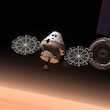 This week in Science Saturday, hear all the latest NASA news, say thanks and give a teary goodbye to Mars Rover Spirit, collect asteroid samples, send humans into deep space, and get a great view of Earth from orbit. All this plus our resident Mars expert’s take on “Bio Station Alpha”, a rumored new tricorder, personal jetpacks, and more!
This week in Science Saturday, hear all the latest NASA news, say thanks and give a teary goodbye to Mars Rover Spirit, collect asteroid samples, send humans into deep space, and get a great view of Earth from orbit. All this plus our resident Mars expert’s take on “Bio Station Alpha”, a rumored new tricorder, personal jetpacks, and more!
A Salute to Spirit: Time to say, “Thanks and farewell” to a Mars Rover
It’s been over a year since Mars Rover Spirit became stuck in a sand trap near Troy, Mars. Attempts were made to free the stuck rover, but NASA wasn’t able to get her out before the onset of Martian winter, during which Spirit would become too cold to operate. Since then, we have been sending signals to Spirit, but we’ve had no response. On May 25, 2011, NASA officially called off the search and stopped attempts to contact Spirit.
Spirit was one of twin Mars Exploration Rovers (sister rover of Opportunity, who’s still operating on Mars), and was only originally expected to last 90 days. Spirit’s mission went for almost seven years. During that time, Spirit photographed Martian dust devils, sun sets, the Martian moons, and discovered a lot about Mars’s past geologic history. Thanks, Spirit, for all of those amazing years of science!
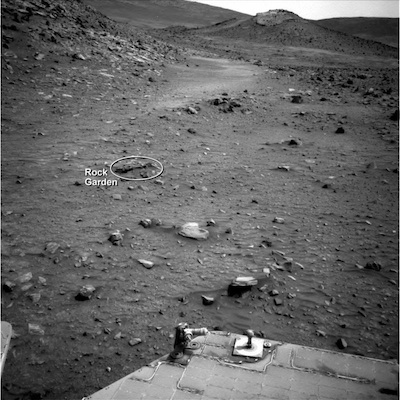
One of the last photographs taken by Spirit showing the site “Troy” where she became stuck
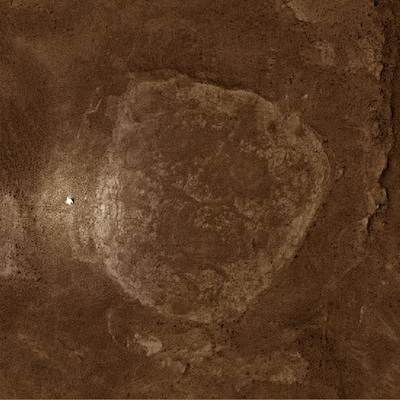
HiRISE image of the Spirit rover at Troy, taken from Martian orbit on the MRO orbiting spacecraft
NASA going to asteroid in 2016, bringing back samples
NASA has just green lit OSIRIS-REx, the first U.S. mission to carry samples back from an asteroid to Earth. The mission, called Origins-Spectral Interpretation-resource Identification-Security-Regolith Explorer (I kid you not, that is what the acronym “OSIRIS-REx” stands for. Sigh.), will launch in 2016 and head for the primitive, near Earth asteroid 1999 RQ36. When it arrives in 2020, it will not actually land on the surface, but “dock” with the asteroid, extending a robotic arm to collect a sample. Only a little over 2 ounces of space rock will make it back to Earth in 2023. Not only is this a pioneering mission for spacecraft engineering and mission design, but it will be the first sample of its kind, and scientists hope that it can tell us about the conditions of the formation of our solar system.
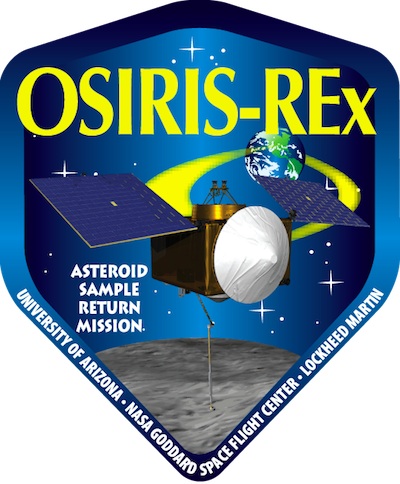
OSIRIS-REx mission patch
NASA developing new capsule to take humans into deep space
As the Space Shuttle program comes to a close, the US has finally announced concrete plans for the next human-rated launch vehicle and capsule. The MPCV, or Multi-Purpose Crew Vehicle, is based on the Orion capsule and will take astronauts beyond Low Earth Orbit (LEO) and into deep, interplanetary space. The MPCV would ride atop a human-rated heavy lift rocket, which the president has allocated $3 billion toward constructing. Could this be the vehicle to take humans to Mars and beyond?
For more information and news, see NASA’s official website.
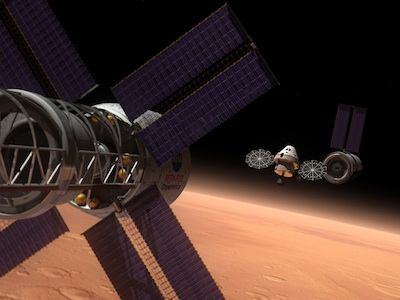
Artist conception of the new space capsule orbiting Mars
(click to encapsulate)
Astronaut delivering astonishing images of Earth from space
As we send things into space, we humans like to take a look back at the good old blue marble once in a great while. Astronaut Douglas Wheelock (@Astro_Wheels on twitter) has been tweeting some INCREDIBLE images of our home from orbit. Below are some of the best. Follow him & check out his twitter page for more!

Greek islands on a clear night during our flight over Europe. Athens shines brightly along the Mediterranean Sea.

Of all the places of our beautiful planet few can rival the beauty and richness of colors in the Bahamas. In this photo, our ship is seen against the backdrop of the Bahamas.

Beautiful atoll in the Pacific Ocean, photographed using 400mm lens. Approximately 1930 km south of Honolulu.

At the southern end of South America lies the pearl of Patagonia . The amazing beauty of rugged mountains, massive glaciers, fjords and seas combined in perfect harmony.
Exciting rumor of the week: Apple’s first CEO, Michael Scott, announces plans for a real Star Trek tricorder
In an interview with Business Insider Apple’s original CEO, Michael Scott, announced that he is working on a device that would basically be a real life Star Trek Tricorder!
“I’m working on a tricorder. It’s from the first Star Trek. It’s a handheld gadget where you hold it out and it tells you what something was. So I’m working on the libraries that would let you take something the size of a cell phone and if you’re walking out the trail, aim it at a rock, and it’ll tell you whether it’s a sapphire, and emerald, etc. So the technology is there now. What’s not there is the library routine that tells you what things are.”
Is this actually going to happen? Does this tech even exist yet? Your guess is as good as mine. But, it’s exciting to think that someone with brains, know-how, and (arguably most importantly) money is looking into it.
Read the entire interview here.
Crackpot of the Week: Space Station on Mars! (not)
Tabloids and UFO Top Secret cover-up style websites have been picking up a new story that a “space station” has been found on Mars. They’ve come up with a fancy name, Bio Station Alpha. David Martines, who discovered a grouping of light colored pixels at 71°49’19.73”N, 29°33’06.53”W with Google Earth for Mars, made a YouTube video (below) that’s been picked up by The Sun, among other tabloids. He claims that it looks like some “well maintained” building of some sort. “I hope it’s not a weapon,” says Martines.
TrekMovie’s resident Mars imaging expert, Andrew Britton, found some high resolution images of the area for comparison using GIS software known as JMARS (Java Mission-planning and Analysis for Remote Sensing), a program used by NASA scientists that’s free for anyone to download! Britton had this to say about the “space station”:
I looked at the feature located at the same coordinates. Loading in the Context Camera imagery from NASA’s Mars Reconnaissance Orbiter at ~6 meters per pixel you can see barchan sanddunes. The wind is coming from the NW and blowing to the SE based on the orientation of the dunes.
As you can see there is no station on the ground. The feature that is pointed out by David Martines is likely to be an image artifact by compression.
Check out the image found by Martines of the supposed “space station” and the comparison, high-res image below.

Bio Station Alpha? This is the image found by Martines

The high res image at the same location
Image taken by the CTX camera, more info
Gadget of the Week: Commercial jetpack tests explosive parachute at 5,000 feet
The now famous Martin Jetpack, the first will-be commercially available jetpack, has just successfully tested an explosive parachute to allow the craft to drift to the ground from a staggering height of 5,000 feet. The explosive charge releases the parachute fast enough for it to be effective. Check out the video below!
Via DVICE.
In case you missed it…
- Watch Space Shuttle Endeavor blast off, from the point of view of the booster cameras: SHUTTLE LAUNCH
- 50 years after JFK’s historic speech, committing humans to land on the moon, a look at the current state of NASA: OBAMA GROUNDING JFK’S SPACE LEGACY?
- Danish team successfully tests a homemade space capsule, designed to send cramped humans into space. I’m hereby dubbing this a “space coffin”: DIY SPACE TRAVEL

Yea, that Hi Res. picture showing mounds on Mars… could thoes be from Babylon 5 Mars Bio Domes Exposed at last!!!
Sorry, to few screwdrivers last night.
Some pretty amazing Pics. Great Article.
Cool Article. I was fortunate enough recently to get a personal tour at JPL and see the new Mars Rover. It was a treat to say the least.
SPACE RULES
“HiRISE image of the Spirit rover at Troy, taken from Martian orbit on the MRO orbiting spacecraft”
How come we can take a picture from orbit where we can see the Spirit rover, but it is not possible to take a high enough resolution image of the Moon that can show us the Apollo Lunar landers which are far larger?
And before you ask, I do not subscribe to the “Lunar landings were faked” conspiracy theories… :)
@Mark Lynch
Have you heard about the Lunar Reconnaissance Orbiter Camera on NASA’s LRO?
http://lroc.sese.asu.edu/news/index.php?/archives/76-LROCs-First-Look-at-the-Apollo-Landing-Sites.html
http://lroc.sese.asu.edu/news/?archives/137-Exploring-the-Apollo-17-Site.html
The camera is not as high resolution as HiRISE on MRO. The LRO camera is at around 0.5 meters per pixel.
i was watching the booster tank views with the GF. pretty much wow’ed… especially the intertank views with the kooky-spooky noises from the tank…
Splendid article. Now I have something to show my crack-pot neighbor who wears a calico-patterned robe, and believes that everything has a taste of conspiracy to it.
Re: Orion to Mars:
Alright, will Anyone who is willing to spend 1 to 2 years in a phone booth with 5-6 other guys, no pizza delivery, and 1 toilet, please raise your hand?
Oh, and there’s no “I changed my mind after 2 weeks” option.
71°49′19.73”N, 29°33′06.53”W
You’ll notice the 1973 North? 1973 was when the last lunar mission was launched! And 2933 West? That’s the year Hitler’s 1000 year Reich was due to end! Coincidence? You be the judge!
Is “Bio Station Alpha” anywhere near where Mars Rover Spirit got “stuck” and stopped transmitting? Hmmmmmmmmm…..
8.@ Charley W. I agree. I was horrified to read in (I think) one the popular science magazines about the conditions under which the astronauts would be working in that tiny capsule for the 6 month voyage to Mars. I say 6 months because it seems that they are looking for people who don’t mind making a one-way journey. They don’t think they can pack enough fuel for a return voyage. I kid you not!
Make that 5-6 other SUICIDAL guys.
I vote we shut down one war, and go to Mars. Who’s with me?
@ 11 CmdrR
Hey, it looks like we’re getting out of Iraq. Boy, we found a lot of weapons of mass destruction. NOT.
@ 10
Last November, some scientists suggested that we send explorers to Mars on a one way trip. The proposal was called “To Boldly Go.” Keith Olberman video and ABC story below.
I wrote a Star Trek prologue for any fool… er explorer who decides to go on the one way trip. Here it is.
“Space. The final frontier. And for you it is. This is the voyage of the Mars Ship Hemlock. It’s mission. Dump your ass on Mars. And if a Martian tries to eat your brains or you get fried from the radiation. Tough luck. That’s because we ain’t coming back for you.”
Olbermann story;
http://www.msnbc.msn.com/id/21134540/vp/40225360#40225360
ABC news story on one way trip
http://abcnews.go.com/Technology/mission-mars-boldly/story?id=12607453
Apple iCorder. The future is now.
@13. Basement Blogger. LOL! After watching these two videos it occurs to me that it just might be easier to imprint human engrams into androids than it would be to establish human colonies on Mars for the following reasons:
1. What if funding runs out for NASA? Do we leave those colonists stranded and just let them die?
2. How do we keep human waste (which contains more microbes than anything else) from contaminating the Martian ecosystem?
3. Mars is very machine-friendly. Rovers which were designed to last only 9 months lasted over 7 years. (Thin atmosphere, little water, no oxidation!)
4. I don’t think Mars has a molten iron core like earth which creates magnetic fields which deflect cosmic rays. How long do you think colonists would last before they either fry or mutate into creatures with a taste for human flesh?
5. What do you do with mentally ill astronauts? If the trip there does not drive them nuts, the endlessly bleak Martian landscape will.
No, my fellow carbon-based life forms, he future is not human beings on Mars. It’s Data on Mars. We should be designing him right now!
15. VulcanFilmCritic
4. I don’t think Mars has a molten iron core like earth which creates magnetic fields which deflect cosmic rays. How long do you think colonists would last before they either fry or mutate into creatures with a taste for human flesh?
I’ll take a stab at it, VulcanCritic.
Answer: A long time. Just as we simulated it on the ‘Moon’ in the 60’s & 70’s.
4. MRO’s HiRISE camera can’t photograph the whole surface. It would take decades to transmit back all the data, so it is only used for specific targets. the wide angle “context camera” is what actually maps the whole planet, and is probably where this photo originated. they use HiRISE to survey priority targets, like potential ice deposits and future landing sites. They also scouted ahead for Spiriit, Opportunity, and Phoenix, and searched for wreckage of MPL and Beagle 2. They could use HiRISE on this object, but if nothing turns up, the crackpots would just cry ‘cover up’, so why bother?
8 and 10… Orion would only be used to get to a Mars ship and back. The crew will live in something like one of the Space Station modules for the trip out and back. I have no idea why that illustration shows Orion free-flying at Mars, it certainly won’t do that.
9. The last lunar mission was launched December 7, 1972.
I’m going to be first in line to get one of those Martin jet packs.
17 @Thorny I’m sorry to contradict you but I think they intend to use that sardine can to get to Mars! It’s supposed to be similar to the Apollo spacecraft which sent men to the moon. They intend to practice the Mars mission on the moon, since the journey will take only three days, but they will stay on the moon for six months. The Mars trip, if they are to return, would take three years, because they have to wait for the planets to re-align.
That’s the true horror of the situation. The closeness. The claustrophobia. The odor. And outside, certain death. There is no “outside.” Yuck!
There is no prison on earth so horrible.
Get real, NASA! Before they start sending guys to the moon, maybe they should practice here on Earth with six astronaut stuck in a capsule for three years in Death Valley or Antarctica or something.
From Reuters:
http://www.reuters.com/article/2009/03/30/us-space-orion-idUSTRE52T6XH20090330
There’s gotta be a great science fiction story here somewhere.
19… No, it isn’t. It isn’t even possible, Orion/MPCV will have a standalone lifetime of only 21 days, far too short to get to Mars and back. Orion will just be a ferry from the ground to the Mars ship and then back again when the Mars ship returns to Earth. The Mars mission itself will be a “stack” of modules, probably including a nuclear propulsion unit, propellant tankage, some sort of docking apparatus for the Mars Lander, and at least one habitat module (based either on Space Station or Bigelow’s inflatable module technology) where the crew will live for the 6 to 9 month flight out to Mars and the even longer flight home. Orion will be kept with the Mars Ship so that it can serve as a radiation shelter in case of solar flares, and so that a critical rendezvous with a return ship is not required when arriving at Earth.
The moon landing missions of Project Constellation were to be about two weeks… one lunar day. There isn’t much point in staying during lunar night, because it is too dark to get anything done on the moon.
20. @ Thorny. Thanks for clarifying that. The news media seemed to suggest otherwise. I’m feeling a little bit better about the mission now.
On this site, I’ve had to debate many Trekkers who say Star Trek is not intelligent. Usually, I go over great episodes and the serious science fiction writers who have written for Star Trek. I also go over the scientific concepts of Star Trek. Warp drive, communicators that inspired cell phones, nanites, etc. Now I can say tricorders.
I do think the most of the technology for the tricorder is there, but as he said the library is also not there.. the issue is we do not have the following, a big enough hard drive (SSD as plater base would be to slow) and a battery that would last long enough.
The scanning technology and camera technology are there.
Another thing would be the screen, we are getting in to bendable screens which will help, but i believe it will need to have a touch screen as the scan will pick out a lot of objects (not just one)
Also it will need to have very fast wireless capabilities.. something we do not have constant across the global. While Military would have this, consumers would not.
This device will also need to incorporate what our smart phones do (phone/email/etc) as if it only scans.. its just a scanner.. not a tricorder. (Yes I do know the tricorder on star trek did not do this, but we only saw it scan and output different frequency, which is no help to us as we are not bringing down force fields) if it is to be a true tricorder it would need to do more then scan.
Hey, on the news tonight they’re saying that CERN scientists were able to capture antimatter for 15 minutes!
Maximum warp!
While I don’t consider it to be an actual “space station” or whatever, I’m not so sure that “object” on Mars is an “artifact” of compression. I’ve been a professional graphic artist for over 12 years and I’ve NEVER seen ANY compression artifacts that looked like that. Ever.
@25 Alfred McEwen had a better idea
“It looks like a linear streak artifact produced by a cosmic ray,” said Alfred McEwen, a planetary geologist at the Lunar and Planetary Lab at the University of Arizona and the director of the Planetary Imaging Research Laboratory. McEwen is the principal investigator of the High Resolution Imaging Science Experiment (HiRISE), a powerful telescope currently orbiting Mars. “With space images that are taken outside our magnetosphere, such as those taken by orbiting telescopes, it’s very common to see these cosmic ray hits. You see them on optical images and a lot of the infrared images too.”